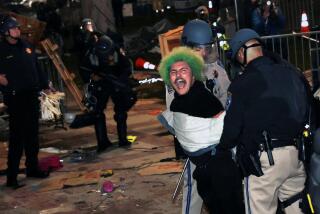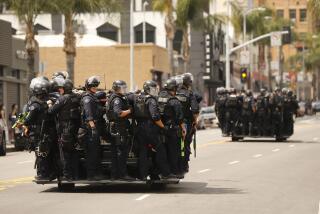Police Sued Over Use of Pepper Spray on Protesters
SAN FRANCISCO — Armed with videotapes of law enforcement officers methodically swabbing liquid pepper spray into the eyes of nonviolent protesters, attorneys sued the Humboldt County Sheriff’s Department and the Eureka Police Department on Thursday for violating the civil rights of environmental demonstrators.
The 90 minutes of videotape--striking for an overall sense of calm, not drama--paint a picture of polite police officers carrying out a well-planned strategy against protesters posing no obvious threat of physical harm during two separate sit-ins.
“Law enforcement has a continuum of force,” attorney Mark Harris said after filing the federal lawsuit here on behalf of nine protesters. “They may not use pepper spray to force someone to do something when they are not resisting.”
To the women and men who had the pain-inducing liquid applied to their unprotected eyes this fall while protesting the harvest of ancient redwoods along the North Coast, the police action was nothing short of torture, they said.
To law enforcement experts, the incident is far less cut and dried. Because the liquid form of oleoresin capsicum has only recently come on the market, there is no legal precedent for its use by law enforcement.
“Pepper spray is usually viewed as a lesser form of force than something that might be more physical,” said Hubert Williams, director of the nonprofit Police Foundation in Washington. “What it means to put the spray in the eye in liquid form I don’t know.”
Humboldt County Sheriff Dennis Lewis referred all calls to county counsel Tamara Falor, who refused to comment because her office had not been served with the suit.
Eureka Police Chief Arnold Milsap did not return repeated telephone calls seeking comment. Capt. Bill Honsal, in charge of field operations, would only say that pepper spray is approved for use by department policy.
“We believe that our directives and our policies provide for the selection of a number of force options, including the use of OC spray or Mace to assist us in making lawful arrests and intervening in situations that could or may become worse,” Honsal said. “You had to be there to understand why we selected that.”
But the American Civil Liberties Union, which has spent several years studying and fighting police use of pepper spray, argues that most law enforcement policies nationwide allow employing the spray only if officers face a serious physical threat.
In the two videotaped incidents--and a third for which attorneys had no videotape--the protesters are alleged to have used no force in resisting efforts by large numbers of officers to arrest them.
“This was not one or two rogue cops in a tense situation going too far,” said John Crew, an attorney with the ACLU in San Francisco. “This was a set of officers . . . carrying out a plan in a clearly intentional manner. Their clear intent was to use this excruciating and serious weapon to extract the degree of compliance that they desired.”
The backdrop for the protests is the Headwaters Forest, believed to contain the largest stands of redwoods in the nation not under government protection.
Much of this forest is owned by Pacific Lumber Co. When Charles Hurwitz took over the firm 11 years ago, he revealed plans to speed the removal of the biggest and oldest trees for lumber.
After nearly a decade of protest and negotiations, federal officials are moving to acquire 7,500 acres of old-growth redwoods near Eureka from Pacific Lumber.
Environmentalists have long argued that the whole forest should be protected. In one of the incidents in question, a protest Sept. 15 at Pacific Lumber’s Scotia headquarters, seven demonstrators staged a sit-in in the company’s lobby.
The seated men and women linked arms through metal tubes called “black bears,” which keep officers from applying pressure and pain to separate them. Deputies told the demonstrators to disband. When they would not, the deputies warned them that pepper spray would be used.
Officers warned them at five-, three- and two-minute intervals that if they disbanded, pepper spray would not be used. When the time was up, they gave them another chance to leave and then swabbed the liquid pepper spray into the eyes of a male protester.
“Let go and we put water in your eyes and give you medical treatment,” one deputy said. When the protesters did not, officers proceeded to swab the burning liquid into the eyes of three others.
“When you first get it applied, it’s so painful,” said Vernell “Spring” Lundberg, 17, one of the protesters at Pacific Lumber. “You think about the burning and your face being eaten by this acid.”
*
When asked why she did not leave when ordered to by police, Lundberg said that “if I unlocked my arms I would have been granting them the knowledge that this tactic worked.”
The second taped protest was a sit-in by four women in the Eureka office of Rep. Frank Riggs (R-Windsor). In this instance, two women had the liquid swabbed in their eyes while a third was sprayed in the eyes at close range.
The lawsuit was filed on behalf of the protesters on whom officers applied the pepper spray and the Headwaters Defense Fund, an anti-logging organization.
The group is asking the courts to declare that the use of pepper spray liquid on peaceful demonstrators violates the U.S. Constitution and requests that the court permanently enjoin officers from administering pepper spray during such protests.
More to Read
Sign up for Essential California
The most important California stories and recommendations in your inbox every morning.
You may occasionally receive promotional content from the Los Angeles Times.










